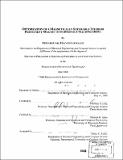| dc.contributor.advisor | Jeffrey H. Lang and Thomas M. Jahns. | en_US |
| dc.contributor.author | Lovelace, Edward Carl Francis | en_US |
| dc.contributor.other | Massachusetts Institute of Technology. Dept. of Electrical Engineering and Computer Science. | en_US |
| dc.date.accessioned | 2005-08-24T19:34:03Z | |
| dc.date.available | 2005-08-24T19:34:03Z | |
| dc.date.copyright | 2000 | en_US |
| dc.date.issued | 2000 | en_US |
| dc.identifier.uri | http://hdl.handle.net/1721.1/9085 | |
| dc.description | Thesis (Ph.D.)--Massachusetts Institute of Technology, Dept. of Electrical Engineering and Computer Science, 2000. | en_US |
| dc.description | Includes bibliographical references (p. 258-263). | en_US |
| dc.description.abstract | Interior permanent magnet (IPM) synchronous machines are attractive because they can achieve constant-power operation over a wide speed range with limited magnet strength requirements and reduced power electronics cost. These characteristics provide the IPM machine with advantages over alternative machine types in applications such as spindle and traction drives. An important challenge for high-performance IPM machine design is to model the magnetic saturation of the core in a manner that is accurate, flexible, and computationally fast for design optimization. A magnetically-saturable lumped parameter model (LPM) is developed for the optimized design of high-performance IPM synchronous machine drives. Using equivalent magnetic circuit analyses, the dq-frame inductances and magnet flux linkage are calculated for transversely-laminated IPM machines. The lumped parameters are employed to predict machine drive system performance for both rated-torque and constant-power operation. The results of saturable model calculations and finite element analysis (FEA) match very closely for the machine inductances, magnet flux linkage, and converted torque. Further validation is presented by comparing measurements of existing experimental machines to predictions from the saturable lumped parameter model. Agreement of measurements and predictions for the highly nonlinear saturable q-axis inductance is within 5% in the saturated excitation range. The utility of the saturable LPM is then demonstrated by developing a cost-optimized design for an automotive integrated starter/generator (ISG) that is rated at 4 to 6 kW during generating operation. This ISG machine is mounted in a direct-drive mechanical configuration on the engine crankshaft. Agreement between the saturable LPM and FEA calculations for q- and d- axis inductances and PM flux linkage are all within 5% for the entire excitation range. Results of this model have been combined with structural FEA and demagnetization studies to produce a machine design that is predicted to meet all key ISG performance requirements. For this application and the chosen cost model, it is shown that optimizing the combined machine and drive system versus optimizing only the machine reduces the overall cost prediction by 12%. | en_US |
| dc.description.statementofresponsibility | by Edward Carl Francis Lovelace. | en_US |
| dc.format.extent | 263 p. | en_US |
| dc.format.extent | 22131018 bytes | |
| dc.format.extent | 22130781 bytes | |
| dc.format.mimetype | application/pdf | |
| dc.format.mimetype | application/pdf | |
| dc.language.iso | eng | en_US |
| dc.publisher | Massachusetts Institute of Technology | en_US |
| dc.rights | M.I.T. theses are protected by copyright. They may be viewed from this source for any purpose, but reproduction or distribution in any format is prohibited without written permission. See provided URL for inquiries about permission. | en_US |
| dc.rights.uri | http://dspace.mit.edu/handle/1721.1/7582 | |
| dc.subject | Electrical Engineering and Computer Science. | en_US |
| dc.title | Optimization of a magnetically saturable interior permanent-magnet synchronous machine drive | en_US |
| dc.type | Thesis | en_US |
| dc.description.degree | Ph.D. | en_US |
| dc.contributor.department | Massachusetts Institute of Technology. Department of Electrical Engineering and Computer Science | |
| dc.identifier.oclc | 46887486 | en_US |
